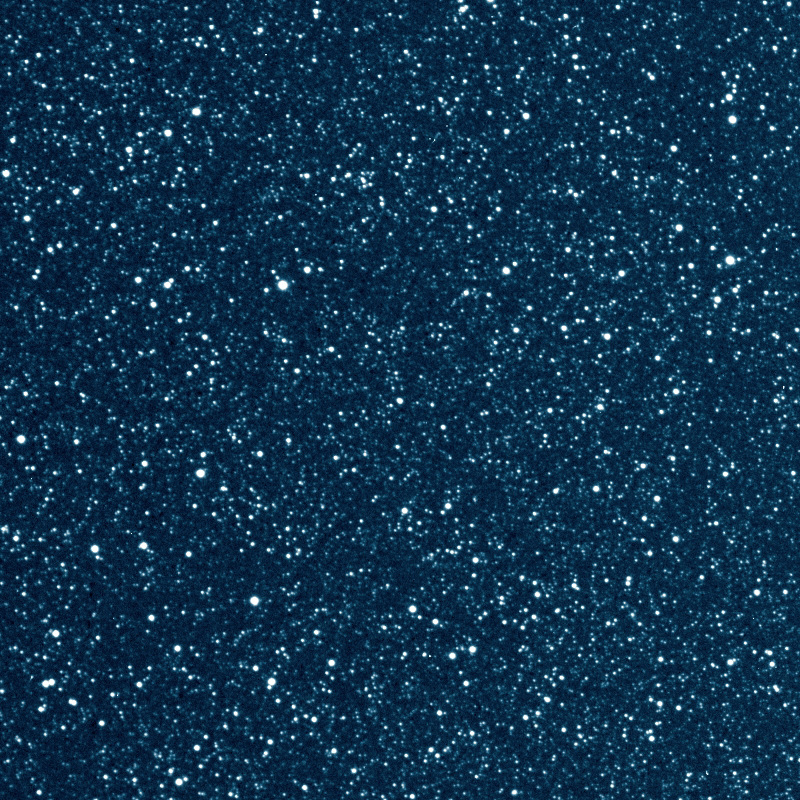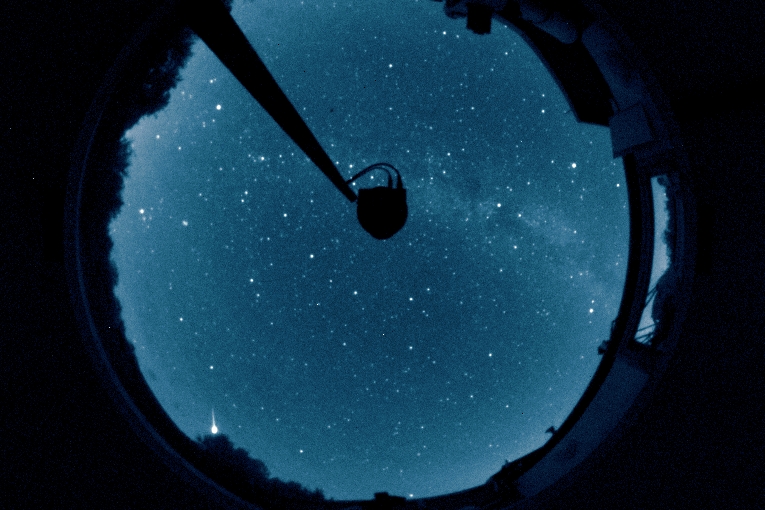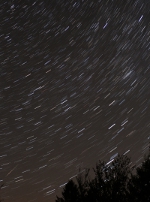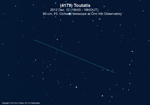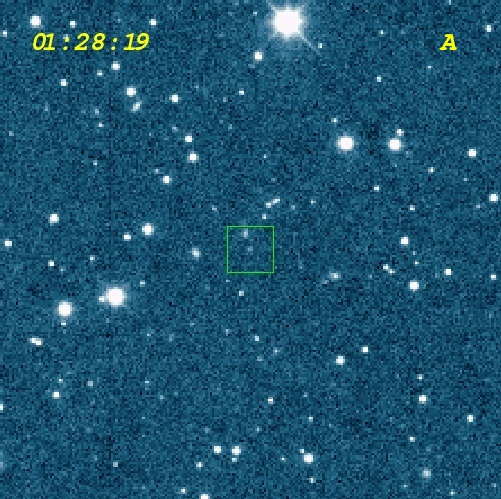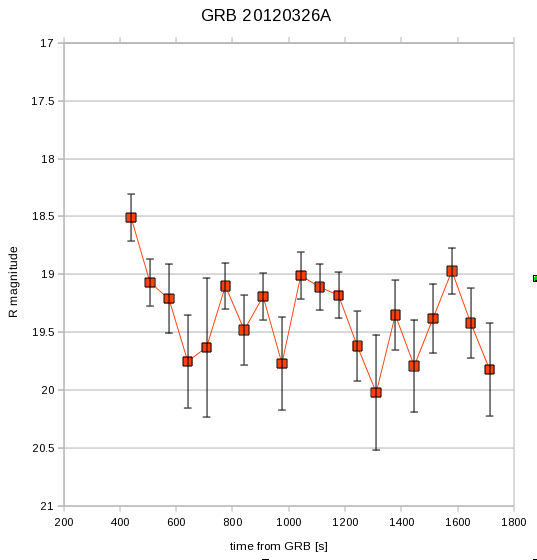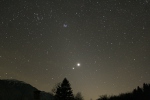| News 2012 - 2014 |
| Fireballs of October 28 and 30 (October 30, 2014) |
|
Two bright fireballs were recorded on 2014 Oct. 28 and 30 with Črni Vrh Observatory
All-Sky Camera. The event of Oct. 28 also left a
fast moving, long lasting afterglow in the upper atmosphere.
|

|
Bright Fireball with Afterglow All-sky camera at Črni Vrh Observatory recorded about -7 magnitude fireball on 2014 Oct. 28, at around 21h03UT with afterglow, lasting for about half an hour. Animation is covering the time interval 21:02:54 - 21:31:03 UT. Copyright © 2014 by J. Vales and PIKA project, Črni Vrh Observatory.
|
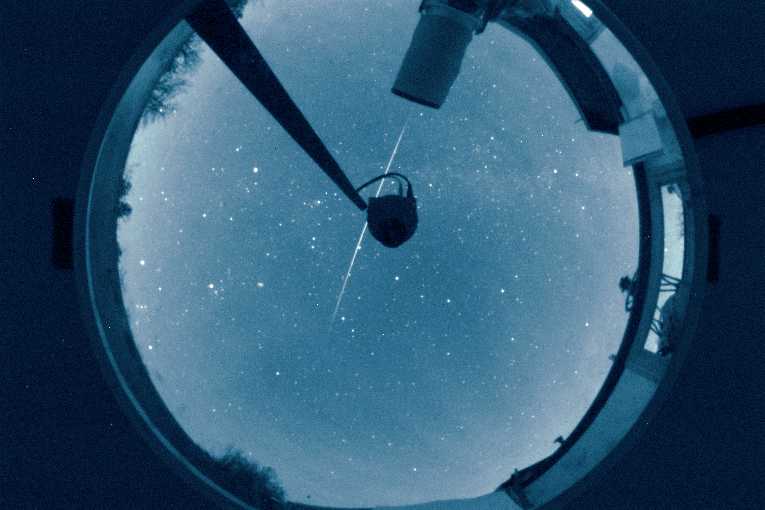
|
Fireball of 2014 Oct. 30 Another fireball was recorded on 2014 Oct. 30 at 21:44:19UT +/-30s. Copyright © 2014 by PIKA project, Črni Vrh Observatory.
|
| Possible Nova in Hercules 2014 (April 10, 2014) | ||||
| Possible nova was discovered by MASTER-Amur auto-detection system as OT source J175924.12+252031.7 at (RA = 17h 59m 24.12s; Dec = +25d 20m 31.7s on 2014 Apr. 9.75507 UT at unfiltered magnitude 12.8m (ATel 6059). |
| We obtained the prediscovery photometry of this object from images taken in the course of Crni Vrh Observatory Wide Field Sky Survey with the 105 mm f.l., f/4 camera lens + AP16E CCD + Rc photometric filter by B. Mikuz, S. Maticic and J. Skvarc. Photometry was performed by B. Dintinjana on several co-added 60 second consecutive exposures. Object is clearly present on Apr. 7 and 8 co-added images. |
Date (UT) co-added frames Rc
2014 Mar 29.979 8 <13.7
2014 Mar 30.967 8 <14.0
2014 Apr 07.034 4 13.22 +- 0.2
2014 Apr 08.047 4 13.74 +- 0.3
|
| The transient was detected also by the All Sky Automated Survey for SuperNovae (ASAS-SN or "Assassin"), using data from the quadruple 14-cm "Brutus" telescope in Haleakala (ATel 6061). |
| Nova Laboda 2014 (1. april 2014) | ||||
|
Novo sta odkrila Japonska astronoma amaterja Koichi Nishiyama in Fujio Kabashima na dveh 40-s CCD posnetkih, narejenih
31. marca 2014 okoli 0,790 UT s 105-mm, f/4 objektivom in kamero SBIG STL6303E. Ob odkritju je bil izmerjeni sij 10,9
magnitude. Njuno iskanje nov kot vse kaže poteka zelo hitro, tako da sta prisotnost objekta potrdila še isti večer 31. marca
ob 0,820 UT. Tokrat sta uporabila precej večji Meade 0.40-m f/9.8 reflektor in kamero SBIG STL1001E. Izmerjene koordinate
objekta so RA = 20h21m42s.34, Dec = +31d03'29".6 (epoha 2000.0). Na njunih prejšnjih posnetkih tega polja dne 27. marca na
tem mestu ni nobenega objekta do mejne magnitude posnetka 13,4. Prav tako na tem mestu ni ničesar na Digitaliziranih
Palomarskih posnetkih neba. Sta pa objekt opazila na posnetku, narejenem 30. marca ob 0,769 UT, ko je imel sij 12,4 magnitude.
Objekt je zatem potrdilo še več amaterskih astronomov in sicer: 1. aprila ob 0,103 UT Gianluca Masi, Francesca Nocentini in
Patrick Schmeer daljinsko s 43-cm teleskopom + CCD blizu kraja Ceccano v Italiji; istega dne ob 0,109 UT, 11,2 magnitude
(Wolfgang Vollmann, Dunaj, Avstrija; vizualno z 0.20-m reflektorjem); 2. aprila ob 0,177 UT, 11.0 (Patrick Schmeer, Bischmisheim,
Nemčija; vizualno z 0.20-m Schmidt-Cassegrain reflektorjem).
Na Astronomskem observatoriju Črni Vrh smo v okviru programa pregledovanja neba s panoramsko kamero (105 mm f. l., f/4 objektiv + AP16E CCD + Rc fotometrični filter) polje nove posneli v kar 6 nočeh pred odkritjem in naredili fotometrijo. Vsako noč posname kamera 4 zaporedne slike istega dela neba z osvetlitvijo 60 sekund. Za izboljšanje razmerja signal/šum smo najprej sešteli slike posameznih noči in nato s programom IRAF naredili fotometrijo. |
|
Povezave:
|
| Svetla supernova v bližnji galaksiji M82 (23. januar 2014) | ||||
|
Supernovo v galaksiji M82 je 21. januarja 2014 odkril Stephen J. Fossey (Observatorij Univerze v Londonu) s skupino njegovih
študentov med izvajanjem praktikuma s 35-cm avtomatskim teleskopom iz kraja Mill Hill, ki se nahaja na severnem obrobju Londona.
Ker se je bližalo poslabšanje vremena jim je mentor namesto predvidenih vaj raje demonstriral delovanje avtomatiziranega
35-cm teleskopa. Študenti so si za opazovanje izbrali lepo in fotogenično galaksijo M82 v ozvezdju Veliki medved. Že na prvih
posnetkih je Fossley sredi galaksije opazil zvezdo, ki jo pri prejšnjih opazovanjih ni bilo na tem mestu.
Eksplozija tako svetle supernove v bližnji galaksiji je zanimiv dogodek za astronome in vse, astronomske navdušence. Ker je večina Slovenije že več tednov pokrita z oblaki smo se člani Društva Temno nebo Slovenije odpravili na opazovanje supernove na sosednjo Avstrijsko koroško, kjer smo na višini preko 1000 metrov uživali pod čudovitim jasnim in neverjetno temnim nebom, ki ga žal zaradi velikega svetlobnega onesnaževanja ni več nikjer v Sloveniji. |
|
Povezave:
|
| Komet ISON ter kometi novembrskega in decembrskega jutranjega neba (November, 2013) | ||||
|
Bližnje srečanje s Soncem je bilo, za komet ISON usodno, saj je zaradi močnih plimskih sil in intenzivnega
segrevanja jedro kometa razpadlo. Razpad kometa je bilo mogoče spremljati na posnetkih koronografov
LASCO C2 in C3, na krovu satelita SOHO, ki neprestano opazuje Sonce in sproti pošilja na Zemljo podatke in slike.
V novembru in decembru 2013 so bili na jutranjem nebu še trije drugi kometi. Med njimi je bil najsvetlejši komet C/2013 R1 (Lovejoy), ki je dosegel sij okoli 4. magnitude in je bil med vsemi kometi najsvetlejši. Več o dogajanju v zvezi z navedenimi kometi je na spodnjih spletnih povezavah. |
|
|
| Very Bright Fireball Over the Northern Adriatic (September 3, 2013) | ||||
|
A
very bright fireball has been observed in early morning of 2013 September 3 over the Slovenia,
Croatia and Northern Italy. The event was imaged with the all-sky camera at Črni Vrh Observatory in
Slovenia. The fireball flash, apparently exceeding the brightness of Full Moon, was recorded at
about 0h13UT, leaving a residual trail of ionized gas for at least 6 minutes. Just 12 minutes later, another bright fireball was recorded on the same part of sky. The flash of light was so bright that the trail of fireball on CCD image is completely saturated.
|
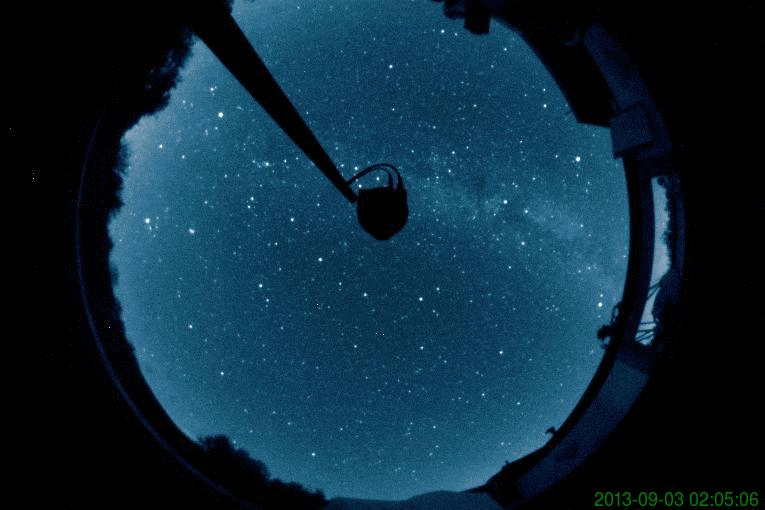
|
Very Bright Fireball Over the Northern Adriatic The animation is composed of 15 images, each lasting for 1 minute and covering the time span of 0h05-0h20UT around the fireball fall. The All-sky Camera at Črni Vrh Observatory is operating on every clear night and record meteors and fireballs on daily basis. See our extensive archive of night sky animations and events since the start of night sky imaging in 2004. Copyright © 2013 Črni Vrh Observatory. |
|
Movie of both fireballs, recorded ar Črni Vrh Observatory Movie of the night sky on 2013 Sep. 2-3, 18h23-3h17 UT with bright fireballs appearing around 0h12 and 0h24UT. Copyright © J. Skvarč, Črni Vrh Observatory. Switch to YouTube |
||||
|
Relevant links:
|
| Nova Delphini 2013 (August 15, 2013) | ||||
|
When discovered by K. Itakagi (CBET 3628)
on Aug. 14.584 UT it was already at unfiltered magnitude 6.8. According to U. Munari et al. in
ATel #5304 and
ATel #5297 the rise toward maximum of Nova Del 2013 was
extremely fast. On unfiltered pre-discovery images for Aug 13.998 UT by Denisenko et al. (CBET 3628), the nova was
still at 17.1 mag, close to its quiescence value (the average magnitude of the progenitor on Palomar I and II plates
is B=17.3 and R=17.6 according to USNO-B1 catalog data, and V=16.9 following GSC ver 2.3.2).
During the 30 hours following the optical discovery, the rate of rise progressively slowed, until the nova reached
V=5.3 on Aug 15.85 when a fast and final rise toward maximum begun (at a 2.5 mag/day rate). They estimate that maximum
was reached on Aug 16.25 at V=4.3. In the scope of the Wide Field Sky Survey Program with 4,0/105mm lens and Apogee U16M CCD camera at Črni Vrh Observatory, the field of Nova Del 2013 has been imaged around Aug. 12.9205UT on four 60-second consecutive R-band exposures, 40 hours before the discovery by K. Itagaki. Nothing is visible at the position of nova down to a limiting magnitude about 13. Unfortunately, we missed the discovery due to cloudy period on next two nights. The same field was imaged again on Aug. 15.9507UT with nova in full outburst at magnitude V=5.3. See the images below.
|
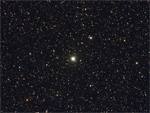
|
Nova Del 2013 True color image of Nova Del 2013, obtained on 2013 Aug. 15 (22h28-22h29UT) with 60-cm f/3.3 Cichocki reflector and standard BVR+L filters. Exposure times was 10s in each filter. Image scale is 2.50 arc sec/pixel. Copyright © 2013 by H. Mikuz, Črni Vrh Observatory. |

|
Nova Del 2013 True color image of Nova Del 2013, obtained on 2013 Sep. 6 (21h18UT) with 60-cm f/3.3 Cichocki reflector and standard BVR+L filters. Exposure times was 10s in each filter. Image scale is 2.50 arc sec/pixel. Copyright © 2013 by H. Mikuz, Črni Vrh Observatory. |
|
Relevant links:
|
| Perseids 2013 (August 13, 2013) |
|
On the night of maximum activity, three bright Perseids were recorded with Črni Vrh Observatory
All-Sky Camera. The sky conditions were excellent
throughout the night. The sky brightness was around 21.3 to 21.4 magnitude.
Report.
|
| Discovery of Supernova 2013eq in uncatalogued galaxy = PSN J17331573+3628352 (July 30, 2013) | ||||
|
H. Mikuz, Crni Vrh Observatory, report the discovery of an apparent supernova (mag 18.5) on
four unfiltered CCD images (bandpass roughly equivalent to the R band) taken during 2013 July 30.882-30.913 UT
with the 60-cm f/3.3 Cichocki reflector
in the course of the Comet and Asteroid Search Program (PIKA).
The object is located at R.A. = 17h33m15s.73, Decl. = +36d28'35".2 (equinox 2000.0), which is approximately
6" east and 18" north of the center of the apparent host galaxy.
Nothing is visible at this position on archival PIKA images obtained on 2013 June 19 and 2011 Mar. 23 (limiting
R-band magnitudes about 19.5) or on several Digitized Sky Survey red and blue images from the Palomar Sky Survey.
|
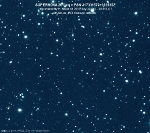
|
Discovery Image of Supernova 2013eq Composite 4x60 seconds image of supernova was made from unfiltered discovery frames taken around 2013 Jul. 30.90 UT with 60-cm, f/3.3 Deltagraph telescope. Image scale is 1.25 arc sec/pixel. Copyright © 2013 by H. Mikuz, Črni Vrh Observatory. |
|
Discovery was announced in CBET Electronic Telegram No. 3616.
Spectroscopic observations,
obtained on July 31.84 and Aug. 1.92 UT by L. Tomasella, S. Benetti, E. Cappellaro, P. Ochner, A. Pastorello, and M.
Turatto, Osservatorio Astronomico di Padova, Istituto Nazionale di Astrofisica, with the Asiago 1.82-m Copernico
Telescope (+ AFOSC), show a blue continuum with broad P-Cyg lines of H-alpha, H-beta, and He I 587.6-nm, indicating that
the object is a type-II supernova shortly after explosion.
Relevant links:
|
| Discovery of a NEO Asteroid 2013 NX23 (Jul. 15, 2013) | ||||
| On 2013 July 15.044UT, NEO asteroid 2013 NX23 was discovered on images taken by Stanislav Matičič in the scope of Comet and Asteroid Search Program PIKA at Črni Vrh Observatory. After posting on Minor Planet Center NEO Confirmation Page, follow-up observations were collected from observers worldwide. Discovery was announced in MPEC 2013-O21. According to orbital elements, the object belongs to the Apollo family of asteroids. |
|
Relevant links:
|
| Discovery of a NEO Asteroid 2013 MX5 (Jun. 18, 2013) | ||||
| On 2013 June 18.05UT, NEO asteroid 2013 MX5 was discovered on images taken by Stanislav Matičič in the scope of Comet and Asteroid Search Program PIKA at Črni Vrh Observatory. After posting on Minor Planet Center NEO Confirmation Page, follow-up observations were collected from observers worldwide. Discovery was announced in MPEC 2013-M26. According to orbital elements, the object belongs to the Amor family of asteroids. |

|
NEO Asteroid 2013 MX5 Animation, composed of four discovery images, obtained with the 60-cm, f/3.3 Cichocki telescope. Copyright © 2013 by S. Matičič, Črni Vrh Observatory, Slovenia. |
|
Relevant links:
|
| Partial Lunar Eclipse (April 25, 2013) | ||||
| The only parial Lunar eclipse of 2013 occured on 2013 April 25 between 19:54:08UT - 20:21:02UT, with maximum eclipse at 20:07:30UT, when the umbral phase magnitude reached 1.47%. At the same time, the penumbral magnitude reached 98.65%. More details on Fred Espenak NASA Eclipse web site. |
|
Partial Lunar Eclipse (April 25, 2013) The eclipse images were taken from Črni Vrh Observatory on April 25 at 19:20h UT to 21:13h UT with a 150 mm f/10 Celestron NexStar 6 SE telescope and Canon EOS650D camera. The movie is composed of 114 images taken in 1 minute intervals, sensitivity set to ISO 200 and exposure time 1/200 sec. The total duration of the eclipse in the movie was 1 hour and 57 minutes. Because the telescope was on alt-az mount, the image field is rotating slowly. Copyright © 2013 by J. Vales, Črni Vrh Observatory. |
|
Relevant links:
|
| Flyby of NEO asteroid 2012 DA14 (February 15, 2013) | ||||
| Due to cloudy weather at Črni Vrh Observatory the flyby of NEO asteroid 2012 DA14 was observed from a Karst region of Western Slovenia, where the sky was quite clear and with the New Moon. The object has been monitored for 70 minutes (20h20-21h30UT), when passing the Earth at a distance of about 30.000 kilometers. Prior to closest approach to Earth in 2013, 2012 DA14 was an Apollo class NEO asteroid with orbital period of 366 days. After encounter, the orbital period was reduced to 317 days and its aphelion was reduced from 1.110 to 0.9917 AU, leaving it almost entirely inside Earth's orbit. It now belongs to Aten group of NEOs. |
|
Flyby movie of NEO asteroid 2012 DA14 Time lapse video of NEO asteroid 2012 DA14 flyby, obtained on 2013 Feb. 15 (20h43-21h50UT) with the Canon EOS 650D camera (ISO 1600) and 50mm f/4.5 lens on a guided mount. Altogether 66 exposures of 1 minute duration were obtained and composed into a video animation. Durind the observation, asteroid moved for about 20 degrees and left a short trail on each exposure due to the fast apparent motion. As the object is quickly receding from the Earth, the trails are progressively shorter and fainter. The image field size is about 23x17 degrees. Observations were carried out from village Pliskovica in a Karst region of W Slovenia. Copyright © 2013 by H. Mikuz and J. Vales, Črni Vrh Observatory. Best watched full-screen, because the asteroid trail is very faint. | ||||
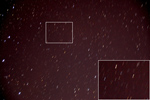
|
Flyby of NEO asteroid 2012 DA14 Image of NE sky with NEO asteroid 2012 DA14 flyby (insert), obtained on 2013 Feb. 15 (20h57UT) with Nikon D5000 camera and 50mm f.2 lens on a fixed tripod. Exposure time was 108s with ISO set to 3200. Copyright © 2013 by Primož Kuk, Voglarji Observatory.
|

|
Flyby of NEO asteroid 2012 DA14 Image of NE sky with NEO asteroid 2012 DA14 flyby (insert), obtained on 2013 Feb. 15 (21h03UT) with Nikon D5000 camera and 18mm f.2 lens mounted on a fixed tripod. Exposure time was 118s with ISO set to 3200. Copyright © 2013 by Primož Kuk, Voglarji Observatory.
|
|
Relevant links:
|
| Flyby of NEO asteroid 4179 Toutatis (December 12, 2012) | ||||
| Using 60-cm Cichocki robotic telescope at Črni Vrh Observatory we imaged the flyby of NEO asteroid 4179 Toutatis on 2012 December 12. The object has been monitored for about one hour (18h55-19h53UT), when passing the Earth at a distance of about 7 million kilometers. Toutatis is an Apollo and Mars-crosser asteroid with orbital period 4.02 years. On December 13, the Chinese lunar probe Chang'e 2, flew by Toutatis at a distance of only 3.2 kilometers and imaged it successfully. |
|
Flyby movie of NEO asteroid 4179 Toutatis The images for this animation were taken using a 60-cm, f/3.3 Cichocki telescope from the Črni Vrh Observatory on 12 December 2012 evening. Each exposure was of 10 seconds. The entire sequence lasted 58 minutes, during which 144 exposures were made. During the observed period, the object apparent sky motion was about 20 arc sec/min. At the time the asteroid was about 7 million km from Earth. Copyright © 2012 by B. Dintinjana, H. Mikuž and J. Vales, Črni Vrh Observatory. YouTube |
||||
|
Relevant links:
|
| Fireball recorded on September 17, 2012 | ||||

|
On 2012 Sep. 17 (4h 29m 22s UT +/-60s) the All-sky camera
at Črni Vrh Observatory recorded about magnitude -10 fireball above the eastern horizon, apparently exploding just in front
of M42 nebula in Orion. The fireball left a
prominent cloud of dust and glowing gas, moving toward the east and lasting up to 50 minutes after the explosion.
The whole event is recorded on
this time-lapse movie, composed
by Jan Vales. Planet Venus is entering frame in the upper left corner. Copyright © 2012 by J. Vales, Črni Vrh Observatory.
|
| Discovery of Supernova 2012em in PGC 69614 = PSN J22440166+1551493 (September 9, 2012) | ||||
|
H. Mikuz, Crni Vrh Observatory, reports the discovery by Blaz Mikuz of an apparent supernova (mag 18.3) on
four unfiltered CCD images (bandpass roughly equivalent to the R band) taken during Sept.
9.895-9.935 UT with the 60-cm f/3.3 Cichocki reflector
in the course of the Comet and Asteroid Search Program (PIKA).
The object is located at R.A. = 22h44m01s.66, Decl. = +15d51'49".3 (equinox 2000.0), which is 14" west and
29" south of the center of galaxy PGC 69614.
Nothing is visible at this position on archival PIKA images obtained on six
nights between 2005 June 16 and 2011 Aug. 2 (limiting mag about 19.0-19.5)
or on several Digitized Sky Survey red and blue images from the Palomar Sky Survey.
|
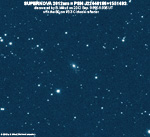
|
Discovery Image of Supernova 2012em Composite 4x60 seconds image of supernova was made from unfiltered discovery frames taken around 2012 Sep. 9.90 UT with 60-cm, f/3.3 Deltagraph telescope. Image scale is 1.25 arc sec/pixel. Copyright © 2012 by B. Mikuz, Črni Vrh Observatory. |
|
Discovery was announced in CBET Electronic Telegram No. 3217.
Spectroscopic observations, obtained on 2012 Sept. 10.95 UT by S. Benetti, L. Tomasella, E. Cappellaro, A. Pastorello, M. Turatto, and
S. Valenti, at Osservatorio Astronomico di Padova, Istituto Nazionale di Astrofisica, 1.82-m Copernico telescope (+ Afosc
spectrograph; range 350-820 nm, resolution 1.3 nm), shows it to be a peculiar type-Ia supernova.
Relevant links:
|
| Discovery of a NEO Asteroid 2012 RH3 (Sep. 8, 2012) | ||||
| On 2012 September 8.85UT, NEO asteroid 2012 RH3 was discovered on images taken by Jure Skvarč in the scope of Comet and Asteroid Search Program PIKA at Črni Vrh Observatory. After posting on Minor Planet Center NEO Confirmation Page, follow-up observations were collected from observers worldwide. Discovery was announced in MPEC 2012-R25. According to orbital elements, the object belongs to the Amor family of asteroids. |
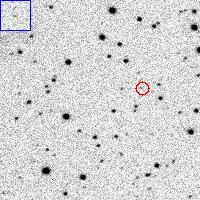
|
NEO Asteroid 2012 RH3 Animation, composed of four discovery images, obtained with the 60-cm, f/3.3 Cichocki telescope. Copyright © 2012 by J. Skvarč, Črni Vrh Observatory, Slovenia. |
|
Relevant links:
|
| Detection of optical afterglow of GRB 120326A at Črni Vrh Observatory (March 26, 2012) | ||||
| We observed optical afterlow of Gamma Ray Burst GRB 120326A (Swift trigger 518626) using 60-cm Cichocki robotic telescope at Črni Vrh Observatory. The series of twenty 60 second exposures with R filter started at 1:27:50UT, 440 seconds after the burst. We confirm optical afterglow at coordinates by C. Guidorzi (GCN 13111). The object was clearly detected on all 20 frames. Complete results are published in GCN 13113 Circular. |
| Discovery of supernova 2012aw = PSN J10435372+1140177 in M95 = NGC 3351 (March 20, 2012) | ||||
|
A supernova of magnitude about R = 13 was discovered on 2012 Mar. 17.90 by J.
Skvarč on four 60 s CCD images taken with a
0.60-m f/3.3 Cichocki
telescope from the Crni Vrh Observatory. The object is at R.A. =
10h43m53s.72, Decl. = +11d40'17".7 (equinox J2000), which is 60" W and
115" S from the center of M95. Nothing is visible on this location in
our PIKA archive images from 2005-04-25, 2005-05-01, 2006-05-04,
2008-11-22, 2010-02-13, 2010-02-24 and 2012-02-15 nor in DSS image
archives. He note that this object is only 3.3 arc seconds from the
X-ray source [SYT2006] s8 listed in the paper
by
Swartz, Yukita, Tennant, Soria and Ghosh. As published in CBET Electronic Telegram No. 3054 the supernova was independently discovered also by two other observers in Italy. Paolo Fagotti, Bastia Umbra at magnitude R = 15 on CCD images taken on Mar. 16.86 UT with a 0.5-m reflector (+ MX916 camera) at Porziano d'Assisi and Alessandro Dimai on Mar. 16.849UT at magnitude 15.4 with 28-cm telescope in the course of the Italian Supernovae Search Project. Image |
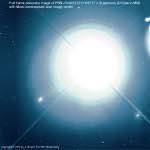
|
Full Frame Discovery Image of Supernova 2012aw Full frame composite discovery image of PSN J10435372+1140177 = Supernova 2012aw in M95 with Mars overexposed near image center. It was composed by adding four 60-s unfiltered exposures, obtained around 2012 Mar. 17.90 with 60-cm, f/3.3 Cichocki telescope at Črni Vrh Observatory. M95 galaxy with supernova 2012aw is near the lower right corner. Mars was only about half degree from this object and this is causing the four diffraction spikes on the composite image. Copyright © 2012 by J. Skvarč, Črni Vrh Observatory. |
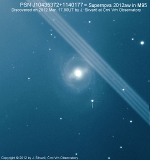
|
Discovery Image of Supernova 2012aw Clip of the image above with M95 galaxy and Supernova 2012aw. Copyright © 2012 by J. Skvarč, Črni Vrh Observatory. |
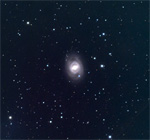
|
Supernova 2012aw True color image of supernova 2012aw, obtained on Mar. 22, 2012 (23h42-0h17UT) with 60-cm, f/3.3 Cichocki telescope. Exposures were 14x60s for luminance and 5x60s for BVR filters. Copyright © 2012 by H. Mikuž, Črni Vrh Observatory. |
|
Discovery was announced in CBET Electronic Telegram No. 3054
together with several spectroscopic observations, which suggest that the object is a very young type-II supernova about 4-5 days after the core-collapse.
Relevant links:
|
| Venus-Jupiter Conjunction on March 14, 2012 | ||||
| Fireball on February 17, 2012 | ||||
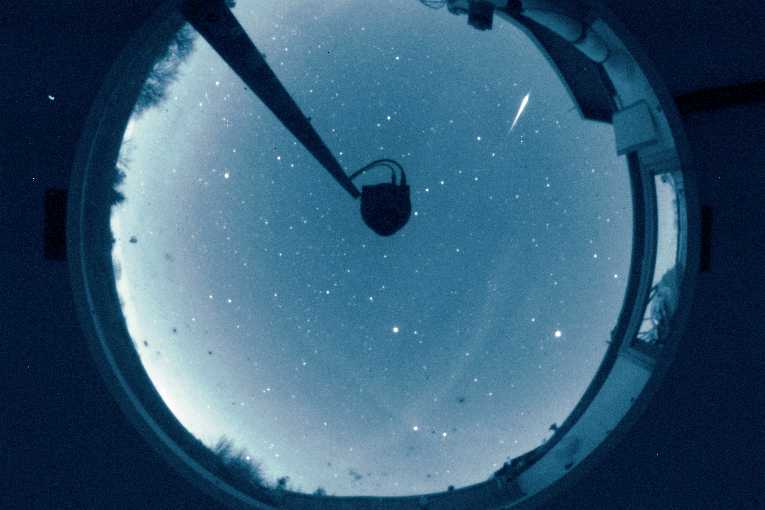
|
On 2012 Feb. 17 (4h 48m 31s UT +/-60s) the all-sky camera
at Črni Vrh Observatory recorded about -5 magnitude fireball over the NW part of the sky. The fireball left a
prominent afterglow which lasted about 10 minutes and is well recorded on this time-lapse movie.
Copyright © 2012 by H. Mikuž and PIKA project, Črni Vrh Observatory.
|
|
|

